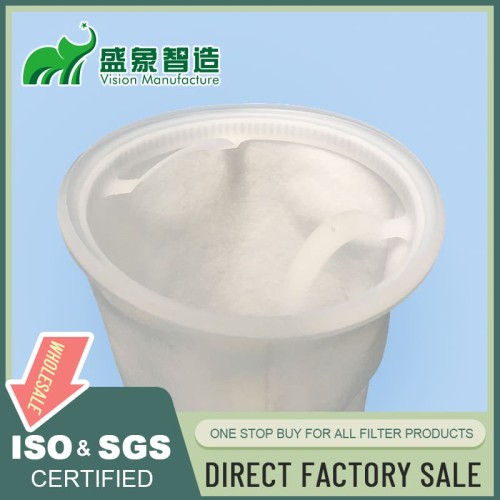
Nylon Filter Socks Offer Versatile Liquid Filtration Solutions
I. Introduction
In industrial settings, liquid filtration is crucial for maintaining system efficiency and product purity. Nylon filter socks, known for their versatility and effectiveness, play a pivotal role in this process. This section introduces the concept of nylon as a filtration material and outlines the benefits of using filter socks in various industrial applications.
II. Nylon Properties in Filtration
Nylon's properties make it an excellent choice for filtration applications:
- Chemical Resistance: Nylon is resistant to a wide range of chemicals, making it suitable for use in harsh environments.
- Durability and Strength: Known for its high tensile strength, nylon can withstand significant stress without tearing.
- Moisture Absorption Characteristics: Nylon's low moisture absorption helps maintain its structural integrity in wet conditions.
- Temperature Tolerance: Nylon operates effectively within a broad temperature range, enhancing its versatility in industrial processes.
III. Filter Sock Design
The design of nylon filter socks is critical for their performance:
- Construction Methods: Including woven and non-woven techniques that influence filtration efficiency and durability.
- Seam Types and Strength: Ensures the integrity of the socks under operational stress.
- Attachment Mechanisms: Features such as rings or hooks that facilitate easy installation.
- Customization Options: Available in various sizes and shapes to meet specific system requirements.
IV. Applications Across Industries
Nylon filter socks are used in numerous sectors due to their effective filtration capabilities:
- Chemical Processing: For filtering out impurities that can affect product quality.
- Food and Beverage Production: Ensures the clarity and purity of consumables.
- Pharmaceutical Manufacturing: Critical in maintaining contaminant-free conditions.
- Water and Wastewater Treatment: Plays a vital role in purifying water for safe use and disposal.
- Paint and Coatings Industry: Filters out particulates to ensure smooth finishes.
- Oil and Gas Sector: Used in the filtration of fluids to prevent contamination.
V. Size and Micron Rating Options
Nylon filter socks come in various sizes and micron ratings to accommodate different filtration needs:
- Standard Sizes and Lengths: To fit common filtration systems.
- Available Micron Ratings: Ranging from coarse to fine filtration options.
- Custom Sizing Possibilities: Tailored dimensions to fit specific applications.
- Multi-layer Designs: For enhanced filtration efficiency.
VI. Performance Characteristics
Key performance metrics for nylon filter socks include:
- Flow Rates and Capacity: The volume of liquid that can be processed efficiently.
- Particle Retention Efficiency: Effectiveness in trapping desired particle sizes.
- Pressure Drop Considerations: Minimal impact on system pressure to maintain efficiency.
- Chemical Compatibility Range: Suitable for various chemicals without degradation.
VII. Selection Guide
Choosing the right nylon filter sock involves several considerations:
- Determining the Right Micron Rating: Based on the size of particles to be filtered.
- Choosing Appropriate Dimensions: Ensuring the socks fit properly within the system.
- Material Grade Selection: Selecting the right type of nylon based on the application.
- Consideration of Process Conditions: Factors like flow rate, temperature, and chemical exposure.
VIII. Installation Best Practices
Proper installation is crucial for maximizing the performance of nylon filter socks:
- Proper Handling Techniques: Ensuring the integrity of the socks during installation.
- Ensuring Correct Fit and Seal: Prevents bypass and ensures optimal filtration.
- Integration with Existing Systems: Compatibility checks to ensure seamless operation.
- Initial Rinse and Preparation: Removes any residues from manufacturing.
IX. Cleaning and Reusability
Nylon filter socks offer significant benefits in terms of maintenance:
- Cleaning Methods and Frequency: Guidelines for effectively cleaning the socks to extend their life.
- Inspection for Wear and Damage: Regular checks to ensure ongoing reliability.
- Regeneration Techniques: Methods to restore filtration efficiency.
- Determining Replacement Timing: Knowing when to replace socks to maintain system performance.
X. Environmental Impact
Using nylon filter socks has a positive environmental impact by:
- Reusability Benefits: Reduces waste compared to disposable filters.
- Waste Reduction Compared to Disposable Filters: Minimizes environmental footprint.
- Proper Disposal Methods: Ensures environmentally responsible handling of used socks.
- Recyclability of Nylon Materials: Promotes sustainability in filter production and disposal.
XI. Cost Analysis
Evaluating the cost-effectiveness of nylon filter socks involves:
- Initial Investment Considerations: Balancing upfront costs with long-term benefits.
- Long-term Cost Benefits: Savings from reduced maintenance and replacement.
- Comparison with Other Filtration Methods: Assessing cost relative to performance.
- ROI Case Studies: Examples of cost savings and efficiency improvements.
XII. Success Stories
Case studies from various industries demonstrate the effectiveness of nylon filter socks in enhancing filtration processes, solving specific challenges, and delivering quantifiable improvements.
XIII. Emerging Trends
Future developments in nylon filter technology include:
- Integration of Nanofibers in Nylon Filter Socks: Enhancing filtration precision.
- Smart Filter Socks with Monitoring Capabilities: Enabling real-time performance tracking.
- Biodegradable Nylon Alternatives: Developing environmentally friendly materials.
- Advancements in Multi-layer Designs: Improving efficiency and capacity.
XIV. Conclusion
Nylon filter socks are revolutionizing the field of industrial filtration, offering unmatched precision and efficiency. As industries increasingly focus on enhancing filtration processes, these socks provide a reliable and cost-effective solution. For organizations looking to optimize their filtration systems, embracing these advanced solutions is a strategic move towards achieving superior operational outcomes.
Leave a comment

